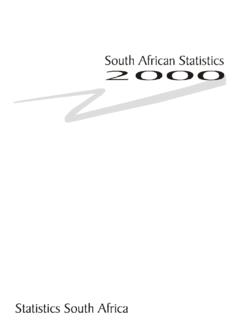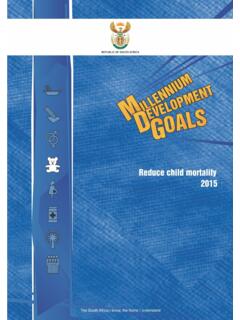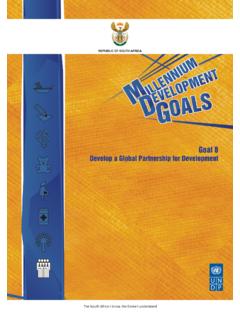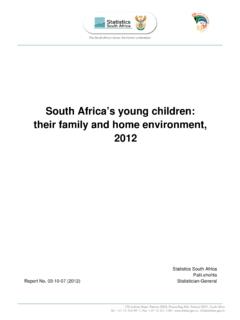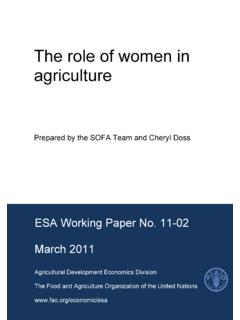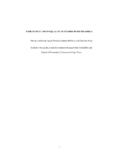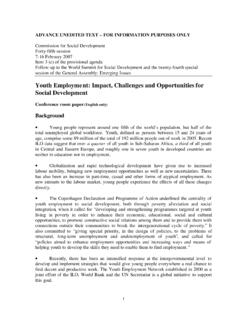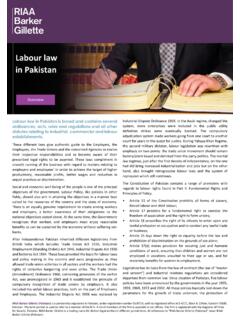Transcription of Quarterly Labour Force Survey (QLFS) Q2:2021 Risenga ...
1 Labour Force Survey (QLFS) Q2:2021 Risenga MalulekeStatistician-GeneralIMPROVING LIVES THROUGH DATA ECOSYSTEMSQ uarterly Labour Force Survey Q2:2021 COVID-19 Impact on Data CollectionRestrictionsnecessarytocombatC OVID-19createdanobstacletonormaldatacoll ectionapproachesandoperations, (CATI).TofacilitateCATI,thesamplethatwas usedforQLFSQ1:2020wasalsousedinallquarte rsof2020andQ1 LIVES THROUGH DATA ECOSYSTEMSQ uarterly Labour Force Survey Q2:202114,97,83,313,5 Other NEA54000 Fewer Employed between Q1 and Q2 2021584 000 MoreUnemployed between Q1 and Q2 2021571 000 Fewer Other Not Economically Active between Q1 and Q2 2021186 000 MoreDiscouraged between Q1 and Q2 202115,07,23,114,1 Other NEAD iscouraged work seekersMMME mployedUnemployedMQ1:2021Q2:2021 Not Economically Active (NEA)There were increases in both unemployed and discouraged work seekers in Q2:2021 MDiscouraged work seekersMEmployedMLabour Force participation comparison between Q1:2021 and Q2:2021 UnemployedMIMPROVING LIVES THROUGH DATA ECOSYSTEMSQ uarterly Labour Force Survey Q2.
2 202114,97,83,313,5 Other NEANot Economically ActiveDiscouraged work seekers16,8 millionILO hierarchy Employed first then unemployed and the remainder is NEA (including discouraged job-seekers). 3 mutually exclusive groups. Cannot be in two groups at the same force22,8million39,6 millionPeople of working age in South Africa (15 64-year-olds)MMME mployedUnemployedSA s official unemployment rate stands at34,4%MIncreased by 1,8 percentage points between Q1:2021 and Q2:2021 Due to rounding numbers may not add upThere were about 54 thousand less people employed in Q2:2021 than Q1:2021 IMPROVING LIVES THROUGH DATA ECOSYSTEMSQ uarterly Labour Force Survey Q2:2021538,7%19,7%16,4%9,7%9,0%6,6% Student Discouraged work seekers Home-maker Too old/young to work Illness/disabilityOtherCharacteristics of the not economically active, Q1:2021 vs Q2:2021 Other reasons include: National lockdown / COVID-19 The number of Not Economically Active persons declined by 386 000 in Q2:2021 compared to Q1.
3 2021q 0,1 % point (-167 000)Q on Q ChangePercentage ChangeAbsoluteChangep1,5 % point (186 000)p1,2 % point (135000)p0,5 % point (48000)p0,3 % point (12000)q 3,3 % point (-600000)IMPROVING LIVES THROUGH DATA ECOSYSTEMSQ uarterly Labour Force Survey Q2:202141,6%37,7%55,9%57,5%30%35%40%45%5 0%55%60%65%20112012201320142015201620172 018201920202021Q2Q3Q4Q1Q2Q3Q4Q1Q2Q3Q4Q1Q 2Q3Q4Q1Q2Q3Q4Q1Q2Q3Q4Q1Q2Q3Q4Q1Q2Q3Q4Q1Q 2Q3Q4Q1Q2Q3Q4Q1Q214,3% Points differenceAbsorption rate is the proportion of the working-age population that is employed19,8% Points differenceLabour Force participation rate is the proportion of the working-age population that is either employed or unemployedThe Labour Force participation rate increased by 1,1 percentage points from 56,4% in Q1:2021 to 57,5% in Q2:2021 Labour Force participation and absorption rates Q2:2011- Q2:2021 IMPROVING LIVES THROUGH DATA ECOSYSTEMSQ uarterly Labour Force Survey Q2:202125,6%32,6%34,4%0%5%10%15%20%25%30 %35%40%Q2Q3Q4Q1Q2Q3Q4Q1Q2Q3Q4Q1Q2Q3Q4Q1Q 2Q3Q4Q1Q2Q3Q4Q1Q2Q3Q4Q1Q2Q3Q4Q1Q2Q3Q4Q1Q 2Q3Q4Q1Q22011201220132014201520162017201 8201920202021 South Africa s unemployment rate increased by 1,8 percentage points to 34,4% in Q2:2021 compared to Q1 rate from Q2:2011 to Q2:2021 IMPROVING LIVES THROUGH DATA ECOSYSTEMSQ uarterly Labour Force Survey Q2:202132,6%34,4%42,6%44,4%0%5%10%15%20% 25%30%35%40%45%50%OfficialExpandedExpand ed Definition includes the following-Official unemployment (searched and available)7,8 M-Available to work but are/or Discouraged work-seekers3,3 M Have other reasons for not searching0,8 MQ2:2011Q2:202111,9million7,8 million10 year periodExpanded unemployment increased by 1,2 percentage points to 44,4% in Q2.
4 2021 compared to Q1 vs Expanded unemployment Q2:2011- Q2:2021 Expanded definition which includes discouraged work-seekers and those having other reasons for not searching ( Lockdown)IMPROVING LIVES THROUGH DATA ECOSYSTEMSQ uarterly Labour Force Survey Q2:20219 Official ExpandedProvincial unemployment rate: Official vs Expanded Q2:202115,8 % points differenceEC recorded the highest official and expanded unemployment rates. LP and NC provinces have more than 15,0 percentage points difference between their expanded and official unemployment ,1%50,3%49,9%47,1%44,4%46,5%46,9%42,7%45 ,2%53,0%25,8%28,1%30,4%32,5%34,4%35,2%35 ,2%35,4%36,5%47,1%WCNCLPKZNRSAMPNWGPFSEC 22,2% points difference19,5% points difference13,1% points differenceIMPROVING LIVES THROUGH DATA ECOSYSTEMSQ uarterly Labour Force Survey Q2:2021 Employment share by sector, Q2:2011 to Q2:2021 The formal sector in South Africa accounts for 68,3%of total Household 1 MFORMAL SECTOR2,3M1,2 MPrivate Household2,7 MFormal sector employment9,8M0,9M0,6MQ2:2011Q2:202168,3 %18,0%8,0%5,8%10,2 MInformal sector employment 1,2 MAgricultureIMPROVING LIVES THROUGH DATA ECOSYSTEMSQ uarterly Labour Force Survey Q2.
5 2021024681012 Formal sector (non-agricultural) Informal sector (non-agricultural) Agriculture Private householdsMillionsQ1:2021Q2:2021 Employment changes by sector, (Quarter-on-quarter increase)q by375 000p by67 000(10,2 million jobs)(2,7 million jobs)(862 thousand jobs)(1,2 million jobs)p by69 000p by184 000 Formal sector employment decreased by 375 thousand jobs between Q1:2021 and Q2:2021 IMPROVING LIVES THROUGH DATA ECOSYSTEMSQ uarterly Labour Force Survey Q2:2021 Employment changes by industryQuarter-on-quarter change ( 000) Decreases were observed in Finance, Community and social services, and ,3%3,6%8,7%6,0%7,3%2,8%0,8%-5,5%-4,6%-11 ,0%Employment declined by 54 000 in Q2:2021 compared to Q1:2021. -278-166-8333666769108143 Mining Utilities Transport Private households Agriculture Trade ConstructionFinanceCommunity and SocialManufacturingIMPROVING LIVES THROUGH DATA ECOSYSTEMSQ uarterly Labour Force Survey Q2:20210,8%2,7%5,7%6,5%8,0%8,2%9,4%15,0% 20,6%22,7% Utilities Mining Agriculture Transport Private households Construction Manufacturing Finance Trade Community and socialservicesShare of Nominal GDP(Q1:2021)25,6%14,9%20,0%12,7%3,1%8,8% 2,8%8,5%3,6%Employment shares, Q2:2021 Employment and GDP share per industryTrade, construction and agriculture have higher employment shares relative to their GDP LIVES THROUGH DATA ECOSYSTEMSQ uarterly Labour Force Survey Q2:202139,1%36,6%24,0%11,0%Less than matricMatricOther tertiaryGraduates0%5%10%15%20%25%30%35%4 0%45%Official Unemployment rate Q2.
6 2021 Graduate unemployment is 23,4% points lower than the national official unemployment rateSA Official Unemployment Rate 34,4%IMPROVING LIVES THROUGH DATA ECOSYSTEMSQ uarterly Labour Force Survey Q2:202164,4%42,9%29,4%21,0%12,4%34,4% 15-24 yrs 25-34 yrs 35-44 yrs 45-54 yrs 55-64 yrs 15-64 yrs22,9%71,4%77,7%73,5%42,2%57,5%8,1%40, 8%54,9%58,0%37,0%37,7%+1,5 Unemployment rateAbsorption rateParticipation rateChange: Percentage points Q1:2021 to Q2:2021 Labour market rates by age group, Q2:2021 Youth aged 15-24 years and 25-34 years recorded the highest unemployment rates of 64,4% and 42,9% respectivelyp 1,1 % point p 1,6 % point p 2,3% point p 1,1 % point q 0,1% pointq 1,9% pointq 0,2% pointq 0,3% pointp 0,3% point p 0,6% point 0,0% (No change)p 2,3% point p 1,5 % point p 0,7% point q 0,7% pointIMPROVING LIVES THROUGH DATA ECOSYSTEMSQ uarterly Labour Force Survey Q2:202133,5%33,9%33,0%39,4%44,7%44,2%0%1 0%20%30%40%50%Q1Q2Q3Q4Q1Q2Q3Q4Q1Q2Q3Q4Q1 Q2Q3Q4Q1Q2Q3Q4Q1Q2Q3Q4Q1Q2Q3Q4Q1Q2Q3Q4Q1 Q220132014201520162017201820192020202115 -24 Years15-34 YearsNEET rate ages 15-24 & 15-34, 2013-2021 Approximately 3,4 million (33,0%) out of 10,2 million young people aged 15-24 years were not in employment, education or training (NEET).
7 The overall NEET rate decreased by 0,8 of a percentage point in Q2:2021 compared to Q2 Years15-34 YearsIMPROVING LIVES THROUGH DATA ECOSYSTEMSQ uarterly Labour Force Survey Q2:202119,5%8,6%28,5%38,2%34,4%WhiteIndi an/AsianColouredBlack AfricanSAUnemployment Rate0%5%10%15%20%25%30%35%40%OFFICIAL unemployment rate by population group, Q2:2021 The unemployment rate among the black African (38,2%) population group remains higher than the national average and other population groups. (From 36,7% in Q1:2021)IMPROVING LIVES THROUGH DATA ECOSYSTEMSQ uarterly Labour Force Survey Q2:20218,1%14,9%25,2%36,7%32,6%8,6%19,5% 28,5%38,2%34,4%WhiteIndian/AsianColoured Black AfricanBoth sexesUnemployment Rateby population GroupQ2:2021Q1:2021 Black women are the most vulnerable with unemployment rate of over 30%.OFFICIAL unemployment rate by population group and sex7,1%19,3%26,0%38,3%34,0%8,2%22,4%29,9 %41,0%36,8%FemaleUnemployment RateBy population GroupQ2:2021Q1:202138,5 Black African women are the most vulnerable with an unemployment rate of 41,0%in Q2:2021 .
8 This is 4,2 percentage points higher than the national average8,9%12,4%24,5%35,4%31,4%8,9%18,0% 27,3%36,0%32,4%MaleUnemployment RateBy population GroupQ2:2021Q1:2021 IMPROVING LIVES THROUGH DATA ECOSYSTEMSQ uarterly Labour Force Survey Q2:202110,1%19,9%34,5%47,9%43,2%11,2%25, 2%36,7%48,7%44,4%WhiteIndian/AsianColour edBlackAfricanBoth sexesExpanded unemployment rate by population groupQ2:2021Q1:202110,2%15,4%32,6%44,7%4 0,1%11,4%21,7%34,8%44,7%40,6%Maleexpande d unemployment rate by population groupQ2:2021Q1:2021 EXPANDED unemployment rate by population group and sex10,0%27,7%36,7%51,5%46,8%11,1%31,7%38 ,8%53,2%48,7%Femaleexpanded unemployment Rate by population GroupQ2:2022Q1:2021 Irrespective of gender, the black African and coloured population groups remain vulnerable in the Labour LIVES THROUGH DATA ECOSYSTEMSA dditional analysis on employment in relation to COVID-19 This section of the presentation focuses on indicators derived from the additional questions that were only asked of those who were employed.
9 IMPROVING LIVES THROUGH DATA ECOSYSTEMSQ uarterly Labour Force Survey Q2:202117,3%82,7% were expected to work during lockdown Of the 14,9 million persons who were employed in Q2:2021 , at least 8 in every ten (82,7%) were expected to work during the national lockdown by the companies/organisations they work distribution of those who worked during lockdown Not expected to work IMPROVING LIVES THROUGH DATA ECOSYSTEMSQ uarterly Labour Force Survey Q2:2021 Worked at place of workWorked from homePlace of work for persons who did any work by occupation, Q2: 2021 Professionals and Managers were more likely than all other occupations to be working from ,1%84,8%88,2%90,3%92,0%94,3%95,8%96,3%98 ,4%99,4%18,9%15,2%11,8%9,7%8,0%5,7%4,2%3 ,7%1,6%0,6% Professional Manager Skilled agriculture Technician Elementary Clerk Craft and related trade Sales and services Domestic worker Plant and machine operatorIMPROVING LIVES THROUGH DATA ECOSYSTEMSQ uarterly Labour Force Survey Q2:202191,0% of the employed continued to receive pay during lockdown 12,8% of those who received pay during lockdown were paid reduced salariesFull salary87,2%Reduced salary12,8%8,5% Did not receive pay0,5% Don t Know91,0% of the employed continued to receive pay during lockdown compared to those in Q1:2021 (91,3%)IMPROVING LIVES THROUGH DATA ECOSYSTEMSQ uarterly Labour Force Survey Q2.
10 2021 About 9 in 10 graduates received their full salary in Q2:2021 . The share of those receiving full salary increasedbetween Q1:2021 and Q2:2021 except among those with matric, where it declined from 86,4% to 85,4%. 83,4%86,4%89,1%91,0%86,5%85,4%89,3%94,0% 0%10%20%30%40%50%60%70%80%90%Less than MatricMatricOther TertiaryGraduatesQ1:2021Q2:2021 Full salary by level of education, Q1: 2021 and Q2: 2021 IMPROVING LIVES THROUGH DATA ECOSYSTEMSQ uarterly Labour Force Survey Q2:2021 RECAP (QLFS, Q2:2021 )Unemployment rate (34,4%) increasedby 1,8 percentage points. Absorption rate (37,7) declined by 0,3 of a percentage point while Labour Force participation rate (57,5) increased by 1,1 percentage (278 000), Community and social services (166 000) and Manufacturing (83 000) recorded the largest employment losses. The number of not economically active decreased by 386 000 in Q2:2021 compared to Q1 LIVES THROUGH DATA ECOSYSTEMSQ uarterly Labour Force Survey Q2:2021 Ndzihelakwala!
